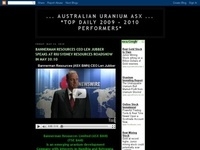Published on Wednesday August 24 2011 (AEST)

Amir Adnani, CEO of Corpus Christi, Texas-based UEC still sees a big bull market in uranium ahead "Politicians are coming to value nuclear power as an increasingly critical tool in our efforts to minimize carbon and greenhouse gas emissions worldwide," said Mr. Adnani. "Of course, more reliance on nuclear power means more need for new uranium supply"
Although the tragedy in Japan temporarily affected uranium share prices, it drew attention to the array of safety features incorporated in western-designed reactors. "In the US alone, nuclear power plants have shown tremendous improvements in their safety records and operating capacity factors," adds Mr. Adnani. "Safe, green and made in America: US nuclear plants have undergone exhaustive studies and have been declared safe in any number of contingencies. Now the US will learn from Japan to make its plants even more safe."
Even the Fukushima reactors, which were very much old nuclear technology, effectively survived an enormously powerful force 9 earthquake with the major meltdown problems being primarily caused by the associated tsunami knocking out the power supply and thus cutting off the plant's cooling systems. This is a hopefully unique occurrence, and one certainly nuclear regulators around the world will be extremely aware of and will enforce standards to prevent this combination of safety failures occurring anywhere else.
Adnani sees an incredible business opportunity in revitalizing sites across America that formerly produced uranium. "There was a thriving uranium market in the US during the 1950s through the mid-1980s," he says. "Then came the uranium bust, and as a result, there is a significant shortage of uranium for the 104 nuclear power plants safely operating in the US. American power plants consume about 55 million pounds of the metal every year to generate 20% of America's electricity, yet the US produces only 3.5 million pounds, and US production has been falling. We rely on imports for about 70% of our oil but foreign countries supply 95% of our uranium. And some of those suppliers are no more stable than certain OPEC members."
 Adnani believes that the uranium sector is facing a severe supply crunch. "Today, primary uranium production only supplies about two-thirds of reactor requirements. The balance is made up for by secondary supplies like the US-Russian HEU Agreement which supplies 13% of worlds or 45% of U.S. annual uranium needs. This agreement expires in 2013, while current forecasts call for greater than 100% increase in uranium demand by 2030," he said.
Adnani believes that the uranium sector is facing a severe supply crunch. "Today, primary uranium production only supplies about two-thirds of reactor requirements. The balance is made up for by secondary supplies like the US-Russian HEU Agreement which supplies 13% of worlds or 45% of U.S. annual uranium needs. This agreement expires in 2013, while current forecasts call for greater than 100% increase in uranium demand by 2030," he said.
Adnani sees an incredible business opportunity in revitalizing sites across America that formerly produced uranium. "There was a thriving uranium market in the US during the 1950s through the mid-1980s," he says. "Then came the uranium bust, and as a result, there is a significant shortage of uranium for the 104 nuclear power plants safely operating in the US. American power plants consume about 55 million pounds of the metal every year to generate 20% of America's electricity, yet the US produces only 3.5 million pounds, and US production has been falling. We rely on imports for about 70% of our oil but foreign countries supply 95% of our uranium. And some of those suppliers are no more stable than certain OPEC members."
There is, though, still some major growth in potential new uranium production ahead, and some in countries like Canada and Australia, and perhaps Namibia and Kazakhstan which don't really fall into Adnani's categorisation of unstable suppliers. Fukushima did knock uranium prices back and will most certainly have led to more difficulty in getting some new projects to fruition.
Some of the world's anticipated new nuclear power plants will be delayed or cancelled altogether as a direct result of the Japanese disaster, but one suspects over time the overt worries will gradually dissipate as they did after Three Mile Island and Chernobyl in the past, but it will take quite a long time and some nuclear capacity will probably have been lost forever - but that doesn't necessarily detract from Adnani's premise which is, in part, a call for the U.S. to become more self-sufficient in uranium output - even just to meet existing demand.
Some of the world's anticipated new nuclear power plants will be delayed or cancelled altogether as a direct result of the Japanese disaster, but one suspects over time the overt worries will gradually dissipate as they did after Three Mile Island and Chernobyl in the past, but it will take quite a long time and some nuclear capacity will probably have been lost forever - but that doesn't necessarily detract from Adnani's premise which is, in part, a call for the U.S. to become more self-sufficient in uranium output - even just to meet existing demand.
 Australian Uranium News - Research
Australian Uranium News - Research


